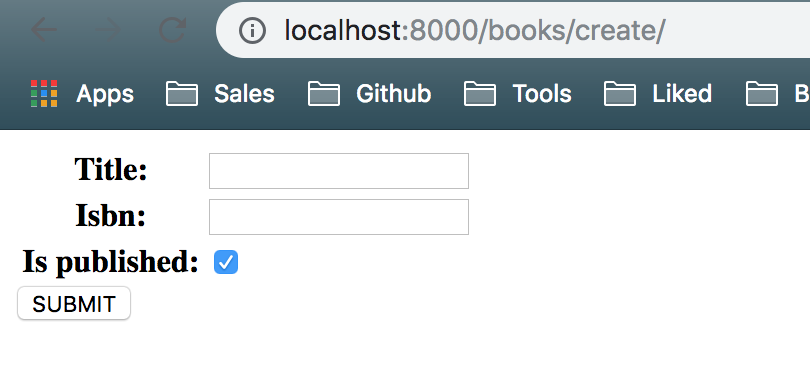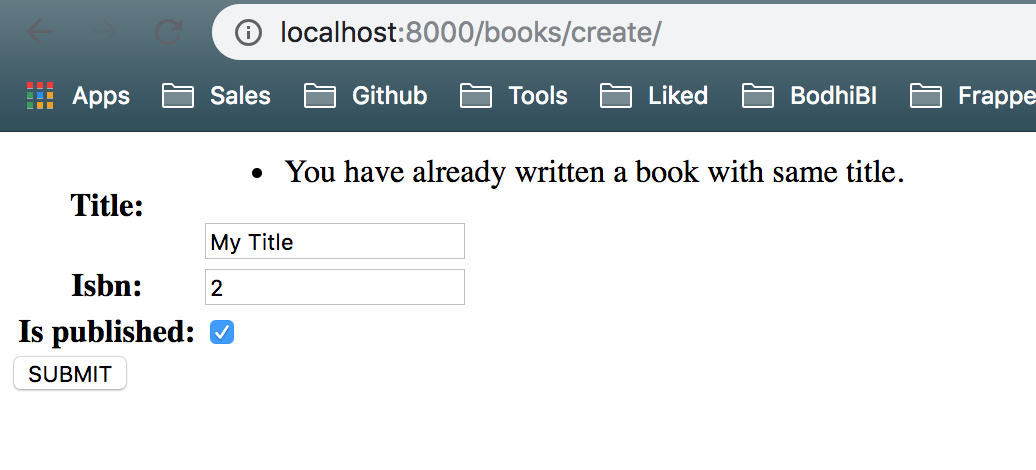When to use CreateView?
Django provides several class based generic views to accomplish common tasks. One among them is CreateView.
CreateView should be used when you need a form on the page and need to do a db insertion on submission of a valid form.
CreateView is better than vanilla View
We will first write a vanilla view by subclassing View, and then modify the view to subclass CreateView instead of View.
CreateView is better than vanilla View in following ways:
- Avoid boilerplate code
- Succinct and more maintainable code.
Vanilla View
We want to create a page with a book creation form.
# books/models.py
class Book(models.Model):
title = models.CharField(max_length=100)
isbn = models.CharField(max_length=100, unique=True)
is_published = models.BooleanField(default=True)
def __str__(self):
return self.title
# books/forms.py
class BookCreateForm(forms.ModelForm):
class Meta:
model = Book
Vanilla view looks like:
# books/views.py
class BookCreateView(CreateView):
def get(self, request, *args, **kwargs):
context = {'form': BookCreateForm()}
return render(request, 'books/book-create.html', context)
def post(self, request, *args, **kwargs):
form = BookCreateForm(request.POST)
if form.is_valid():
book = form.save()
book.save()
return HttpResponseRedirect(reverse_lazy('books:detail', args=[book.id]))
return render(request, 'books/book-create.html', {'form': form})
Template code looks like:
<!--books/templates/books/book-create.html-->
<form action="." method="POST">
{% csrf_token %}
<table>
</table>
<button type="submit">SUBMIT</button>
</form>
With proper urlpattern, you should be able to see the book creation form.
from django.urls import path
from . import views
app_name = 'books'
urlpatterns = [
path('create/', views.BookCreateView.as_view(), name='create'),
path('<int:pk>/', views.BookDetailView.as_view(), name='detail'),
]

Using CreateView
Vanilla view has a lot of boilerplate code.
Any object creation view will have a get() implementation for creating context and rendering the response. Similarly object creation view will have a post() implementation to do .save(). CreateView, which is a generic class based view, can avoid this boilerplate code.
class BookCreateView(CreateView):
template_name = 'books/book-create.html'
form_class = BookCreateForm
This change also needs that a get_absolute_url() be defined on the object which is being created. So we need to provide a get_absolute_url() on model Book.
class Book(models.Model):
# More code
def get_absolute_url(self):
return reverse('books:detail', args=[self.id])
Refresh the page and you should still be able to achieve everything that was possible with vanilla view.
As you would have noticed, using a CreateView helped us avoid boilerplate get() and post() implementation. The code looks much more succinct as it only has few class attributes and there isn’t any function implementation.
Adding initial data to CreateView
Assume we want to populate form’s title field with some initial data.
Modify BookCreateView to look like:
class BookCreateView(CreateView):
template_name = 'books/book-create.html'
form_class = BookCreateForm
def get_initial(self, *args, **kwargs):
initial = super(BookCreateView, self).get_initial(**kwargs)
initial['title'] = 'My Title'
return initial
This code has better separation of concern. There is a separate method for dealing with initial data.
Had we used a vanilla view, initial data code would have been part of get().
Adding form kwargs to CreateView
Let’s add a user field to Book to track the user who creates a Book.
class Book(models.Model):
title = models.CharField(max_length=100)
isbn = models.CharField(max_length=100, unique=True)
is_published = models.BooleanField(default=True)
user = models.ForeignKey(User, on_delete=models.CASCADE, **NULL_AND_BLANK)
def __str__(self):
return self.title
def get_absolute_url(self):
return reverse('books:detail', args=[self.id])
Assume you don’t want to allow a user to create two books with same title. The title should be unique per user.
This validation needs writing a clean_title() method which would look like:
class BookCreateForm(forms.ModelForm):
class Meta:
model = Book
exclude = ('user',)
def __init__(self, *args, **kwargs):
self.user = kwargs.pop('user')
super(BookCreateForm, self).__init__(*args, **kwargs)
def clean_title(self):
title = self.cleaned_data['title']
if Book.objects.filter(user=self.user, title=title).exists():
raise forms.ValidationError("You have already written a book with same title.")
return title
This needs that a user be supplied from view during form creation. This is where CreateView.get_form_kwargs() come into picture. Modify the view to look like:
class BookCreateView(CreateView):
template_name = 'books/book-create.html'
form_class = BookCreateForm
def form_valid(self, form):
self.object = form.save(commit=False)
self.object.user = self.request.user
self.object.save()
return HttpResponseRedirect(self.get_success_url())
def get_initial(self, *args, **kwargs):
initial = super(BookCreateView, self).get_initial(**kwargs)
initial['title'] = 'My Title'
return initial
def get_form_kwargs(self, *args, **kwargs):
kwargs = super(BookCreateView, self).get_form_kwargs(*args, **kwargs)
kwargs['user'] = self.request.user
return kwargs
After this any logged in user wouldn’t be able to create two Books with same title.

Our other posts on generic class views
Thank you for reading the Agiliq blog. This article was written by Akshar on Jan 7, 2019 in django .
You can subscribe ⚛ to our blog.
We love building amazing apps for web and mobile for our clients. If you are looking for development help, contact us today ✉.
Would you like to download 10+ free Django and Python books? Get them here
